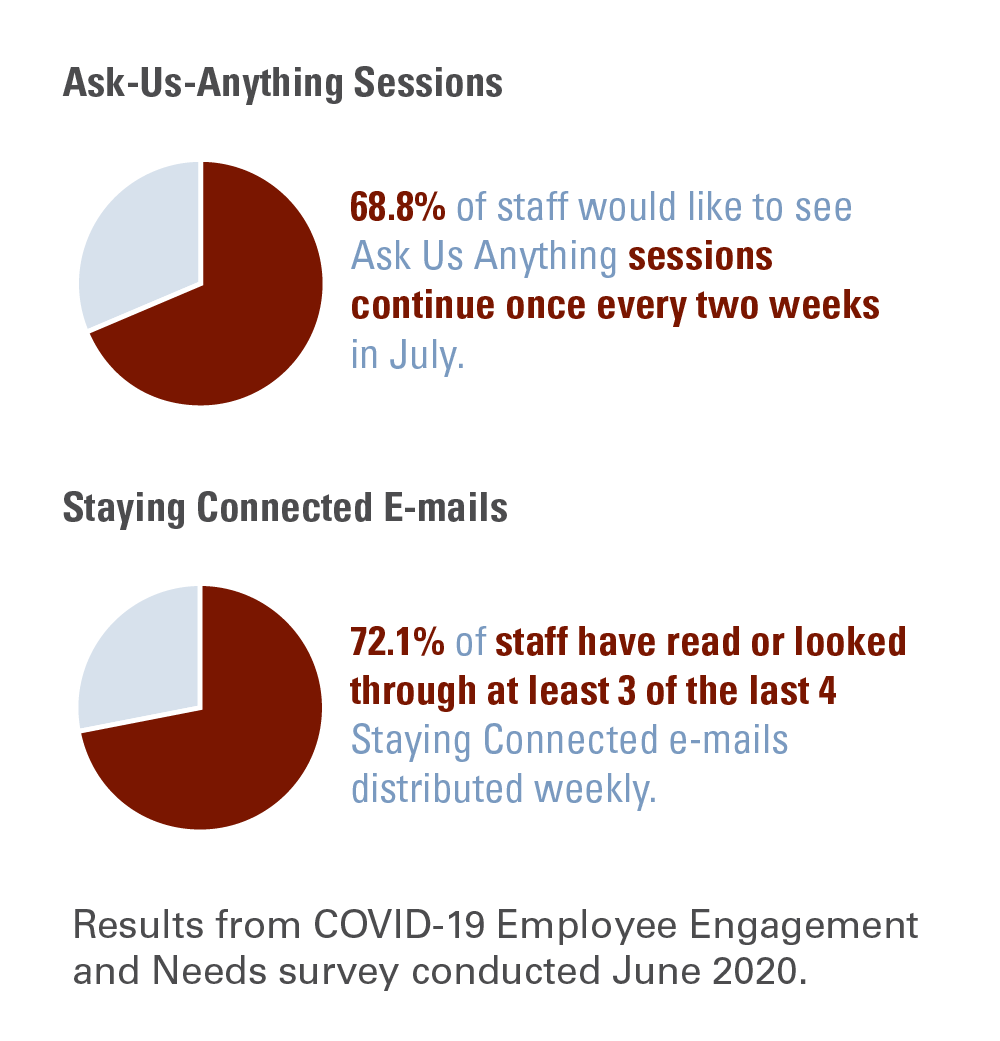Impact of COVID-19 on the ACGO’s Workforce
A rewarding workplace environment with high performing and empowered staff is essential to implementing a successful transformation of the AGCO’s regulatory approach. Engaging staff is a particular challenge with the majority of AGCO’s employees working remotely during the COVID-19 pandemic. The AGCO continues to support staff during this difficult time through a number of operational and well-being measures. Examples include:
- All AGCO staff who are able to work from home have been asked to do so.
- Laptops and other technology have been made available to allow staff to provide services remotely.
- Regulatory activities that are typically conducted away from home (e.g. compliance inspections) have been modified to protect the health and well-being of AGCO employees and the broader public. The AGCO has procured personal protective equipment (PPE) such as masks, gloves, and hand sanitizer and is making it available to field staff.
- A number of activities have been launched to keep staff connected, engaged and supported, including a new “Staying Connected” newsletter.
- The AGCO executive team has implemented regular “Ask Us Anything” video conferences for all AGCO staff to have the opportunity to ask questions directly.
- The AGCO launched its “Back to Business Project” to provide central coordination and oversight over the planning activities to support the reopening of all four sectors the AGCO regulates and the agency’s planning to return to the office.

Text version of the Results from COVID-19 Employee Engagement and Needs survey conducted June 2020.
Expansion of AGCO Regulatory Mandate & Resourcing Constraints
Marketplace evolution and initiatives such as the federal legalization of recreational cannabis and provincial proposal to expand and establish a competitive online market for iGaming in Ontario have continued to expand the AGCO’s regulatory authority. As with other public sector organizations, the AGCO faces the challenge of managing an expanding mandate, often without a corresponding expansion of resources. Public expectations and the AGCO’s visibility continue to rise along with that expanded mandate, particularly during this global health crisis. These challenges underline the importance of focusing regulatory attention on higher-risk areas, so that the AGCO is better equipped to navigate a changing environment.
To help manage the operational and financial pressures related to this expanded mandate, the AGCO continues to implement its long-term direction through its Strategic Plan. The AGCO’s Corporate Plan, which captures all of the AGCO’s major initiatives, supports its expanded mandate by ensuring that initiatives are prioritized based on alignment with its mandate, Strategic Plan, and resource capacity. The Corporate Plan is reviewed by the AGCO’s leadership team on a biannual basis to ensure priorities remain accurate and resourced effectively. This process helps the AGCO manage its limited resources with an expanding mandate.
The AGCO strives to proactively improve efficiencies in its operations, demonstrating its commitment to the government’s goal of regulatory efficiency. Initiatives include implementation of an Enterprise Risk Management (ERM) Framework, numerous program audits to improve efficiencies, and a long-term digital strategy. Additionally, the AGCO’s shift to a risk-based regulatory approach has ensured agency resources are allocated to areas that represent greater risk.
Assessing and Managing Risk
The AGCO proactively identifies risks and uncertainties, which if left unaddressed, could adversely affect the achievement of the AGCO’s strategic goals.
The AGCO leverages sound risk management methodologies through the continued use and enhancement of an ERM Framework to monitor and mitigate these environmental risk factors. ERM is a continuous, proactive and systematic process to understand, manage and communicate risk from an organization-wide perspective and assists management in making strategic decisions that contribute to the achievement of the AGCO’s corporate objectives.
The ERM Framework consists of a portfolio view of risks that includes several risk categories such as strategic, governance, financial, operational, compliance and stakeholder risks. It also assists the organization in identifying areas of risk in a systematic, disciplined and integrated approach. An annual risk workshop is held with the senior management team to identify, assess, and decide on prioritization and mitigation activities for the AGCO’s top risks. These risks and related mitigation activities are updated on a quarterly basis, at a minimum, to ensure they reflect the changing risk landscape. Risk assessment activities are also integrated with the AGCO’s strategic and corporate planning process to ensure that risks arising from the AGCO’s goals and plans are considered and assessed. ERM assists the AGCO in prioritizing its work and is a key criterion in the identification of projects in the annual corporate plan. The AGCO’s ERM Framework and associated processes are overseen by the AGCO Board of Directors who provide input and counsel on the process.
The results of the risk assessment activities are a key input in the development of the AGCO’s Audit and Evaluation Plan which gives priority to areas considered high risk and provides coverage of risk management, control and governance processes. The ERM Framework will continue to form a foundation to guide management’s decision-making processes when developing strategic plans and corporate planning activities.